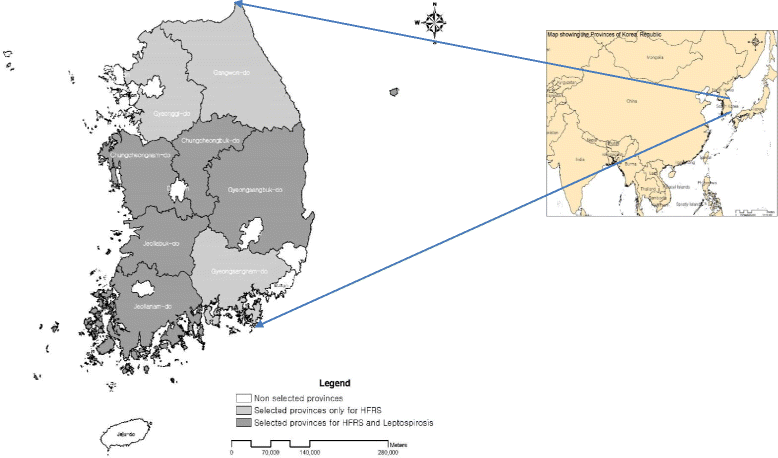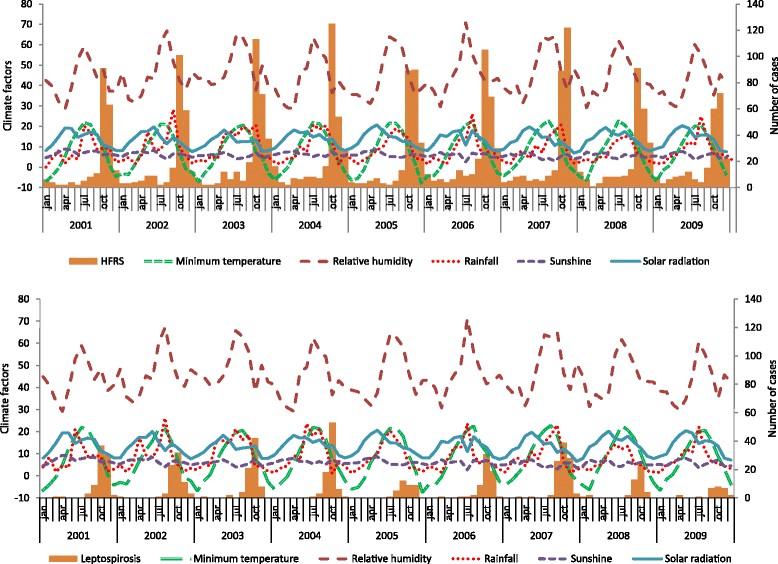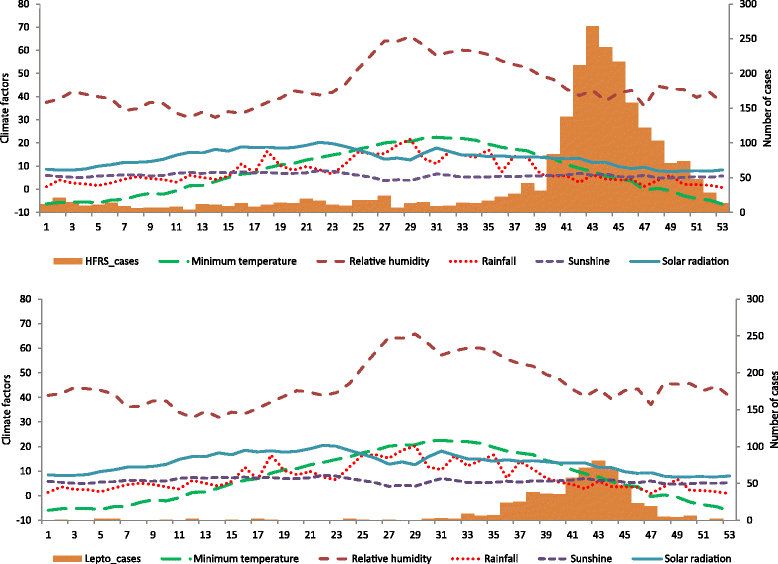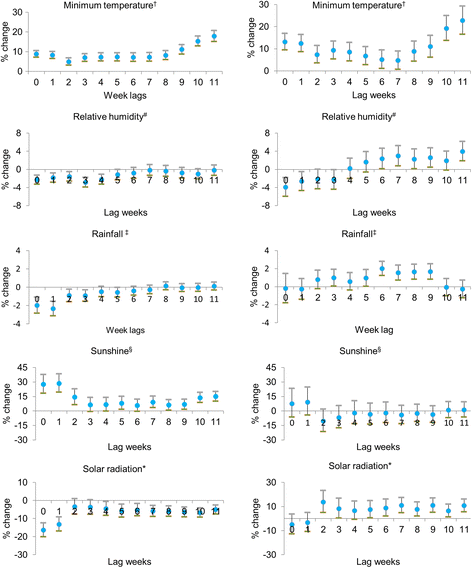The influence of climatic factors on the development of hemorrhagic fever with renal syndrome and leptospirosis during the peak season in Korea: an ecologic study
- PMID: 28592316
- PMCID: PMC5463320
- DOI: 10.1186/s12879-017-2506-6
The influence of climatic factors on the development of hemorrhagic fever with renal syndrome and leptospirosis during the peak season in Korea: an ecologic study
Abstract
Background: Hemorrhagic fever with renal syndrome (HFRS) and leptospirosis are seasonal rodent-borne infections in the Republic of Korea (Korea). The occurrences of HFRS and leptospirosis are influenced by climatic variability. However, few studies have examined the effects of local climatic variables on the development of these infections. The purpose of this study was to estimate the effect of climatic factors on the occurrence of HFRS and leptospirosis in Korea.
Methods: Daily records on human cases of HFRS and leptospirosis between January 2001 to December 2009 were analyzed. The associations of climatic factors with these cases in high incidence provinces were estimated using the time-series method and multivariate generalized linear Poisson models with a maximal lag of 12 weeks.
Results: From 2001 to 2009, a total of 2912 HFRS and 889 leptospirosis cases were reported, with overall incidences of 0.67 and 0.21 cases per 100,000, respectively, in the study areas. The increase in minimum temperature (1 °C) at a lag of 11 weeks was associated with 17.8% [95% confidence interval (CI): 15.1, 20.6%] and 22.7% (95% CI: 16.5, 29.3%) increases in HFRS and leptospirosis cases, respectively. A 1-h increase in the daily sunshine was related to a 27.5% (95% CI: 18.2, 37.6%) increase in HFRS at a lag of 0 week. A 1% increase in daily minimum relative humidity and a 1 mm increase in daily rainfall were associated with 4.0% (95% CI:1.8, 6.1) and 2.0% (95% CI: 1.2, 2.8%) increases in weekly leptospirosis cases at 11 and 6 weeks later, respectively. A 1 mJ/m2 increase in daily solar radiation was associated with a 13.7% (95% CI: 4.9, 23.2%) increase in leptospirosis cases, maximized at a 2-week lag.
Conclusions: During the peak season in Korea, climatic factors play a significant role in the development of HFRS and leptospirosis. The findings of this study may be applicable to the forecasting and prediction of disease outbreaks.
Keywords: Climatic factors; Generalized linear poisson model; HFRS; Leptospirosis; Rodent; Seasonality; Vector-borne disease; Zoonosis.
Figures




Similar articles
-
[The warning model and influence of climatic changes on hemorrhagic fever with renal syndrome in Changsha city].Zhonghua Yu Fang Yi Xue Za Zhi. 2011 Oct;45(10):881-5. Zhonghua Yu Fang Yi Xue Za Zhi. 2011. PMID: 22321585 Chinese.
-
Changes in rodent abundance and weather conditions potentially drive hemorrhagic fever with renal syndrome outbreaks in Xi'an, China, 2005-2012.PLoS Negl Trop Dis. 2015 Mar 30;9(3):e0003530. doi: 10.1371/journal.pntd.0003530. eCollection 2015 Mar. PLoS Negl Trop Dis. 2015. PMID: 25822936 Free PMC article.
-
Epidemiologic study on changes in occurrence of hemorrhagic fever with renal syndrome in Republic of Korea for 17 years according to age group: 2001-2017.BMC Infect Dis. 2019 Feb 13;19(1):153. doi: 10.1186/s12879-019-3794-9. BMC Infect Dis. 2019. PMID: 30760218 Free PMC article.
-
Transmission of haemorrhagic fever with renal syndrome in china and the role of climate factors: a review.Int J Infect Dis. 2015 Apr;33:212-8. doi: 10.1016/j.ijid.2015.02.010. Epub 2015 Feb 19. Int J Infect Dis. 2015. PMID: 25704595 Review.
-
Distribution of geographical scale, data aggregation unit and period in the correlation analysis between temperature and incidence of HFRS in mainland China: A systematic review of 27 ecological studies.PLoS Negl Trop Dis. 2019 Aug 19;13(8):e0007688. doi: 10.1371/journal.pntd.0007688. eCollection 2019 Aug. PLoS Negl Trop Dis. 2019. PMID: 31425512 Free PMC article.
Cited by
-
Quantifying the relationship between climatic indicators and leptospirosis incidence in Fiji: A modelling study.PLOS Glob Public Health. 2023 Oct 11;3(10):e0002400. doi: 10.1371/journal.pgph.0002400. eCollection 2023. PLOS Glob Public Health. 2023. PMID: 37819894 Free PMC article.
-
Climate Change Drives the Transmission and Spread of Vector-Borne Diseases: An Ecological Perspective.Biology (Basel). 2022 Nov 7;11(11):1628. doi: 10.3390/biology11111628. Biology (Basel). 2022. PMID: 36358329 Free PMC article.
-
Spatiotemporal dynamics and risk factors for human Leptospirosis in Brazil.Sci Rep. 2018 Oct 11;8(1):15170. doi: 10.1038/s41598-018-33381-3. Sci Rep. 2018. PMID: 30310115 Free PMC article.
-
Serological Survey of Leptospira spp. in Livestock and Rodents from Different Settlements in the Kilombero Wetland, Tanzania.Pathogens. 2024 Dec 1;13(12):1059. doi: 10.3390/pathogens13121059. Pathogens. 2024. PMID: 39770319 Free PMC article.
-
Association of Warmer Weather and Infectious Complications Following Transrectal Ultrasound-Guided Prostate Biopsy.J Pers Med. 2022 Mar 11;12(3):446. doi: 10.3390/jpm12030446. J Pers Med. 2022. PMID: 35330445 Free PMC article.
References
MeSH terms
LinkOut - more resources
Full Text Sources
Other Literature Sources

